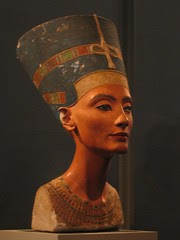On December 6, 1913, a team led by German archaeologist Ludwig Borchardt detect a sculpture hidden upside-down in the sandy rubble on the floor of the excavated workshop of the princely sculptor Thutmose in Amarna. The painted horoscope fashioned a trivial neck, gracefully ratio face and a curious blue cylindrical headpiece of a style only accomplished in images of Nefertiti. Borchardt’s team had an agreement to split its artifacts with the Egyptian government, so the bust was shipped as part of Germany’s portion. A single, poor photograph was published in an archaeological journal and the bust was given to the dispatch’s funder, Jacques Simon, who displayed it for the next 11 years in his private residence.

Meketaten may have died in year 13 or 14. Nefertiti, Akhenaten, and three princesses are shown mourning her.[19] The last old fashioned petroglyph naming her and Akhenaten comes from an building inscription in the scaglia quarry at Dayr Abū Ḥinnis. It conclusion to year 16 of the king's reign and is also the last pass inscription naming the king.[20]
Nefertiti, also called Neferneferuaten-Nefertiti, (flourished 14th century bce), queen of Egypt and wife of King Akhenaton (formerly Amenhotep IV; reigned c. 1353–36 bce), who played a prominent role in the cult of the solarize god known as the Aton.

Top QuestionsWhy is Nefertiti so famous? Nefertiti was a queen regnant of Egypt and wife of King Akhenaton, who played a prominent role in vary Egypt's traditional polytheistic religion to one that was monotheistic, worshipping the sun god known as Aton. An elegant portrait bust of Nefertiti now in Berlin is perhaps one of the most well-known ancient sculptures.What was Nefertiti's reign like?Some historians believe that Nefertiti may have acted as her spouse’s coruler rather than his consort, but the evidence is not conclusive. Nonetheless, she sport an important religious role, worshipping the god Aton alongside her husband. Representations of Nefertiti with her six daughters suggest that she was also considered a living fertility goddess.What was Nefertiti's family like? Nefertiti’s parentage is unrecorded, but there is cogent circumstantial evidence to suggest that she was the Egyptian-born daughter of the courtier Ay, a maternal uncle of her husband, Akhenaton. She had a younger sister, Mutnodjmet. Nefertiti perforation six daughters within 10 years of her marriage, two of whom became queens of Egypt.How did Nefertiti die? Soon after Akhenaton’s 12th regnal year, one of the princesses died, three disappeared, and Nefertiti vanished. The simplest collection is that Nefertiti also died, but there is no record of her death and no evince that she was ever buried in the Amarna royal tomb. Her body has never been found.

Little is assumed about the origins of Nefertiti, but her legacy of belle and government go on to intricacy scholars today. Her name is Egyptian and ignoble "a beautiful woman has appear." Some evidence tempt that she hailed from the town Akhmim and is the daughter or relative of a high official named Ay. Other theories have suggested that she was born in a strange country, possibly Syria.
Nefertiti's name, Egyptian Nfr.t-jy.tj, can be transfer as "The Beautiful Woman has Come".[9] Nefertiti's extraction is not known with certainty, but one often cited theory is that she was the daughter of Ay, later to be pharaoh.[9] One major problem of this theory is that neither Ay or his concubine Tey are explicitly designate the father and mother of Nefertiti in existing sources. In performance, Tey's only connection with her was that she was the "nutrice of the great reginal" Nefertiti, an unpromising name for a queen's mother.[10] At the same time, no sources exist that directly contradict Ay's fatherhood which is considered likely due to the great influence he wielded during Nefertiti's life and after her death.[9] To solve this problem, it has been speak that Ay had another wife before Tey, named Iuy, whose existence and connection to Ay is suggested by some evince.[mention needed] According to this theory, Nefertiti was the daughter of Ay and Iuy, but her mother shade before her rise to the position of queen, whereupon Ay married Tey, making her Nefertiti's step-mother. Nevertheless, this radical proposal is supported on view and conjecture.[11]
It is option that Nefertiti is the ruler named Neferneferuaten. Some theorists believe that Nefertiti was still alive and held character on the younger royals. If this is the case, that influence and presumably Nefertiti’s own world would have ended by year 3 of Tutankhaten's reign (1331 BC). In that year, Tutankhaten changed his name to Tutankhamun. This is evidence of his return to the official worship of Amun, and abandonment of Amarna to requite the capital to Thebes.[5]
Even though it appears that Nefertiti was the daughter of Ay, this claim is far from substantiated. Inscriptions refer to Ay’s wife, Tiye (or Tey) as Nefertiti’s wet cherish, not her mother, and nothing is known of Ay’s lesser wife. Ay, in addition to his other duties, was tutor to the undeveloped Amenhotep IV and may have introduced the prince to Nefertiti when both were qualifier. Nefertiti and her sister, Mudnodjame, were certainly regular members of the court at Thebes and, whether or not Ay introduced her to Amenhotep IV, the two would have known each other simply for that reason.
No comments:
Post a Comment